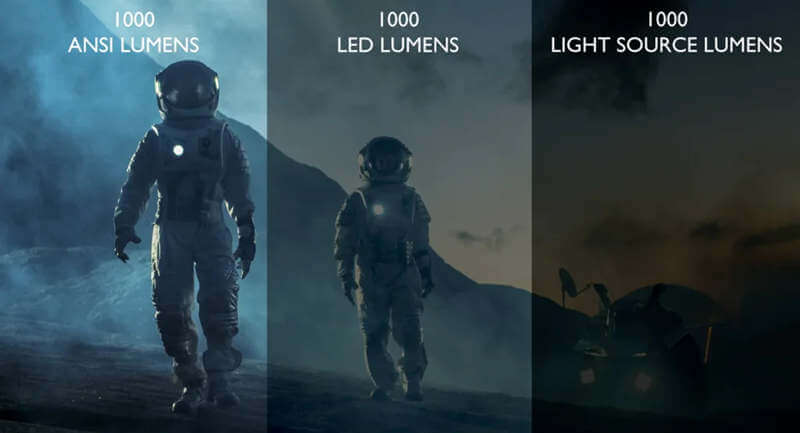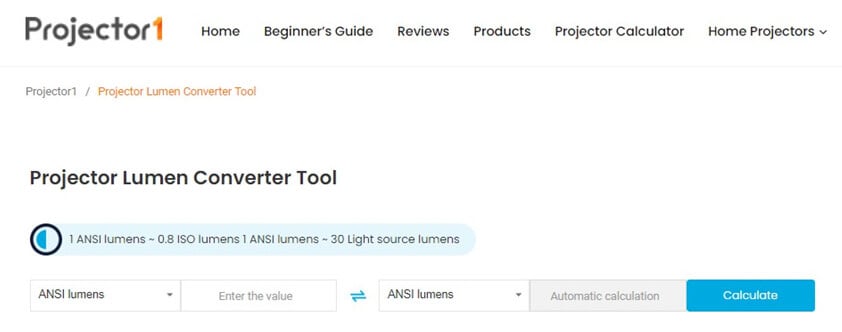Brightness is a core parameter for a projector’s image and the lumen is the unit of the brightness of the projector. As we all know, the higher the lumens figure, the brighter the image of the projector. Many projector brands on the market label their projectors with higher light source lumens to make their products appealing and deceptive. In fact, some projectors labeled with ANSI lumens or ISO lumens are much brighter though their figures are smaller than the figure of light source lumens.

There is an ANSI to Lumens converter, which supports conversion between different lumens units on the market, protecting you from the high-brightness traps. Before introducing the converter, you need to know about the common 6 lumens units on the projector market, including Lumens, ANSI lumens, ISO lumens, light source lumens, the LED lumens, and Lux.

Common 6 Projector Brightness Units
1. Lumen
A lumen is a general unit of brightness. It describes the luminous flux of a light source. When speaking of a projector, it measures the light intensity of a light source.
However, lumens labeled on the projector market are just a general term. You have to further check its specific lumens unit. Sometimes, it refers to light source lumens, but sometimes it refers to ISO lumens or ANSI lumens. That is the word games and traps you need to take care of.
2. ANSI lumens
ANSI lumen is the internationally recognized and standard brightness unit for the projector. It is defined by American National Standards Institute and measured by a 9-point test. ANSI lumens represent the brightness observed on the projection image.

3. ISO lumens
ISO lumen is also an internationally recognized unit. It is a unit defined by the International Organization for Standardization. Specifically, it now refers to the ISO 21118 specification.
4. Light source lumens
Light source lumen is not international standards either. It indicates the brightness observed directly from a light source. On the market, many projector sellers will label light source lumens as lumens directly. The lumen generally refers to the light source lumen if the projector has no additional explanation for its brightness unit.

5. LED Lumens
LED Lumen is not an international standard and it is only adopted by several LED projector manufacturers. It reflects the brightness sensed by the human eye, which is based on the principle of the Helmholtz–Kohlrausch (HK) effect.
Generally, 1,000 LED lumens can be converted to 417 ANSI lumens.
In other words, ANSI lumens= LED lumen value ÷ 2.4 or LED lumens value=2.4 ⅹ ANSI lumens.
*The exact conversion rate depends on the efficiency of the projector’s LCD panel of the projector brand.
6. Lux
Lux is a unit of illuminance, which measures how much the luminous flux is spread over a given area.
Lumen vs Lux
lumen measures the total quantity of visible light, while illuminance describes the intensity of illumination on a surface.
You can convert lux and lumen as follows:
- 1 Lux= 1 lumen÷ m2 (square meter)
- Lumen =Luxⅹscreen area
How to Use the ANSI to Lumens converter?
After learning the brightness units on the projector markets, you may feel confused. Don’t worry, you can use the ANSI to Lumens converter to convert different lumens units conveniently and easily.
By selecting the two units and inputting the figure, you can quickly get the corresponding lumens figure.
For example, the projector has 2,000 ISO lumens, and then it can be converted to 2,500 ANSI lumens.
For another example, the projector has 6,000 lumens, and then it can be converted to 200 ANSI lumens.

It is worthy to note that the conversion result is just for reference because the light source lumen is not internationally recognized and is not a standardized unit.
Related Posts
How Much Does a Projector Cost?
What are Lumens or ANSI Lumens?
Lumen vs Lux: What are the Differences?
LED Lumens VS ANSI Lumens: What Are the Differences?
What are Lumens or ANSI Lumens?
ANSI lumens vs ISO lumens: What Are the Differences?




